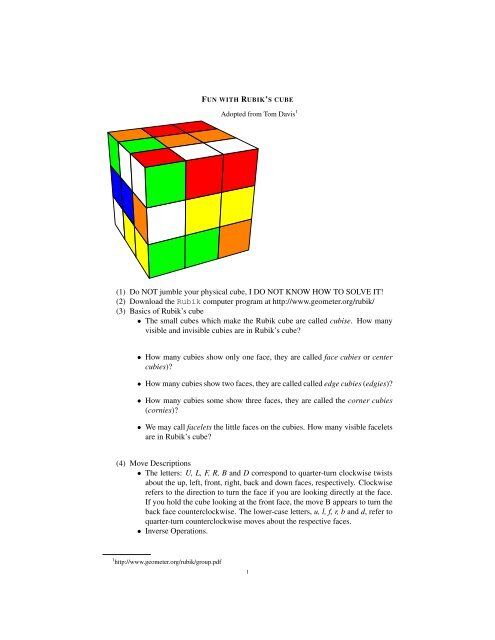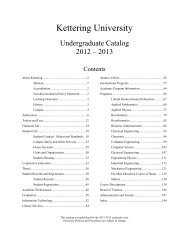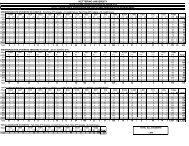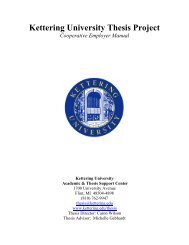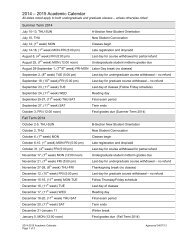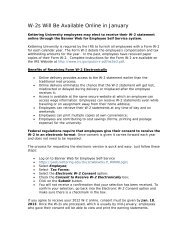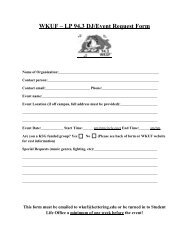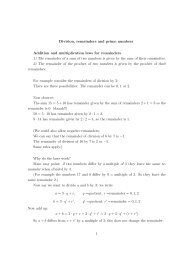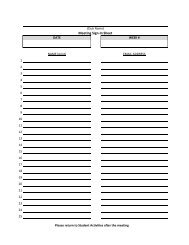Rubic Cube Basics and Groups.pdf
Rubic Cube Basics and Groups.pdf
Rubic Cube Basics and Groups.pdf
Create successful ePaper yourself
Turn your PDF publications into a flip-book with our unique Google optimized e-Paper software.
FUN WITH RUBIK’S CUBE<br />
Adopted from Tom Davis 1<br />
(1) Do NOT jumble your physical cube, I DO NOT KNOW HOW TO SOLVE IT!<br />
(2) Download the Rubik computer program at http://www.geometer.org/rubik/<br />
(3) <strong>Basics</strong> of Rubik’s cube<br />
• The small cubes which make the Rubik cube are called cubise. How many<br />
visible <strong>and</strong> invisible cubies are in Rubik’s cube?<br />
• How many cubies show only one face, they are called face cubies or center<br />
cubies)?<br />
• How many cubies show two faces, they are called called edge cubies (edgies)?<br />
• How many cubies some show three faces, they are called the corner cubies<br />
(cornies)?<br />
• We may call facelets the little faces on the cubies. How many visible facelets<br />
are in Rubik’s cube?<br />
(4) Move Descriptions<br />
• The letters: U, L, F, R, B <strong>and</strong> D correspond to quarter-turn clockwise twists<br />
about the up, left, front, right, back <strong>and</strong> down faces, respectively. Clockwise<br />
refers to the direction to turn the face if you are looking directly at the face.<br />
If you hold the cube looking at the front face, the move B appears to turn the<br />
back face counterclockwise. The lower-case letters, u, l, f, r, b <strong>and</strong> d, refer to<br />
quarter-turn counterclockwise moves about the respective faces.<br />
• Inverse Operations.<br />
1 http://www.geometer.org/rubik/group.<strong>pdf</strong><br />
1
2<br />
– Apply an F move, you can undo that by turning the same face a quarterturn<br />
counter-clockwise by doing an f move.<br />
– Apply move F followed by R. How can you undo this move?<br />
– In mathematics, an operation that undoes a particular operation is called<br />
the inverse. This is usually denoted by writing a −1 exponent. We can<br />
write F −1 in place of f , or f = F −1 . In algebra we write 1 2 = 2−1 .<br />
– What is (FR) −1 =? Explain the double reversal idea.<br />
– Find an inverse of the sequence f f RuDlU, <strong>and</strong> check if it works using<br />
the Rubik computer program (be VERY careful if you use your physical<br />
cube).<br />
• Powers.<br />
– We will write FFF = F 3 , the 3 in the exponent indicates that the operation<br />
is repeated three times.<br />
– Write FRFRFRFRFR as a power.<br />
– What is F 9 =?<br />
– We call the operation of doing doing nothing the identity operation <strong>and</strong><br />
will label it here as 1 (like when you multiply a number by 1, you do<br />
nothing.<br />
– What is F 0 =?.<br />
• Commutativity <strong>and</strong> Non-Commutativity.<br />
– The order in which you apply moves makes a difference. Take your<br />
physical cube <strong>and</strong> apply an FR to it <strong>and</strong> have your friend apply RF to<br />
his/her cube. FR ≠ RF.<br />
– In ordinary arithmetic 7 × 9 = 9 × 7. When the order does not matter,<br />
as in multiplication of numbers, we call the operation commutative.<br />
If the order does matter, e.g. for division of numbers (give an example)<br />
then we say that the operation is non-commutative.<br />
– Find in your cube moves that are commutative. Find number divisions<br />
that are commutative.<br />
• Order.<br />
– Perform any move you want 4 times. The resulting cube returns to a<br />
solved state. We can write F 4 = 1.<br />
– How many times do you need to apply FR to return to the solved cube?
3<br />
– The smallest number of repetitions for a move, or for a sequence of<br />
moves, to go from a solved cube to a solved cube, is called the order of<br />
this move, or of a sequence of moves.<br />
– Find the order of FFRR using a physical cube (dont make a mistake).<br />
– Check your answer with Rubik. Here is how: Reset the cube to solved<br />
<strong>and</strong> type FFRR into the window labeled CurrentMacro. Then press the<br />
Macro Order button just above the window in which you just typed, <strong>and</strong><br />
Rubik will pop up an information window showing you the order that<br />
it calculated.<br />
– Apply the FFRR operation repeatedly until the cube is solved to check<br />
the answer. Here is how: With the cube in Rubik solved <strong>and</strong> FFRR<br />
in the CurrentMacro window, click the Apply Macro button. Click the<br />
same Apply Macro button again <strong>and</strong> again until the cube returns to<br />
solved.<br />
– Reset the cube again, use the same FFRR is in the Current Macro window,<br />
click in that Current Macro window with the mouse just before the<br />
first F <strong>and</strong> press the return key repeatedly on your keyboard. Rubik<br />
then twists the cube faces as you watch.<br />
– Explore Rubik.<br />
– Start with a solved cube. Try a different sequence repeatedly using<br />
Rubik, will you get back to the solved cube?<br />
(5) Important Property of Rubik’s <strong>Cube</strong>: Any cube operation has an order. This means<br />
that if you begin with a solved cube <strong>and</strong> repeatedly apply the same move, or a<br />
sequence of moves, you will return to a solved cube after a finite (could be 4,<br />
1000, or more) number of steps.<br />
• Solve this problem: The number of possible rearrangements of facelets is<br />
smaller than what number?<br />
• Recall the Pigeonhole Principle. If more than K pigeons are to be placed in<br />
K pigeonholes then there must be at least two pigeons in one pigeonhole.<br />
• What number of repetitions of any operation has to get you through two identical<br />
states of Rubik’s cube? What are the pigeon <strong>and</strong> pigeonholes here?<br />
• If you need K repetitions to go between two identical states, how many repetitions<br />
do you need to go from a solved cube to a solved cube?<br />
(6) Useful Macros<br />
• As you know FFRR has order 6. The number 6 is divisible by small numbers<br />
2 <strong>and</strong> 3. What does (FFRR) 2 do to Rubik’s cube? How about (FFRR) 3 ?
4<br />
• Try a different Macro. Find its order. Find small prime divisors of the order,<br />
like 2, 3 or 5. If k is such a divisor, see if your Macro repeated k times is<br />
useful.
What is a Group?<br />
A group G consists of a set of objects <strong>and</strong> a binary operation ∗ on those objects satisfying<br />
the following four conditions:<br />
1. The operation ∗ is closed. In other words, if g <strong>and</strong> h are any two elements of the<br />
group G then the object g ∗ h is also in G.<br />
2. The operation ∗ is associative. In other words, if f, g <strong>and</strong> h are any three elements<br />
of G, then (f ∗ g) ∗ h = f ∗ (g ∗ h)<br />
3. There is an identity element e in G. In other words, there exists an e ∈ G such<br />
that for every element g ∈ G, e ∗ g = g ∗ e = g.<br />
4. Every element in G has an inverse relative to the operation ∗. In other words, for<br />
every g ∈ G, there exists an element g −1 ∈ G such that g ∗ g −1 = g −1 ∗ g = e.<br />
Examples of <strong>Groups</strong><br />
The integers under addition,<br />
The rational numbers under addition,<br />
The rational numbers except for 0 under multiplication,<br />
The real numbers under addition,<br />
The real numbers except for 0 under multiplication.<br />
Rubik cube moves. Why?<br />
All of these groups are infinite <strong>and</strong> commutative.<br />
(Commutative means that a∗b = b∗a for every a <strong>and</strong> b in the group.)<br />
The natural numbers (= {0, 1, 2, 3, . . .}) under addition do not form a group. Why?<br />
We can’t include zero in the rational or real numbers under multiplication. Why?<br />
In the modular arithmetic, if the operation is addition modulo n, the n elements<br />
0, 1, . . . , n − 1 form a group under that operation.<br />
For any particular geometric object, the symmetry operations form a group. A symmetry<br />
operation is a movement after which the object looks the same. For example, there are 4<br />
symmetry operations on an ellipse whose width <strong>and</strong> height are different:<br />
1: Leave it unchanged<br />
a: Rotate it 180◦ about its center<br />
b: Reflect it across its short axis<br />
c: Reflect it across its long axis
The group operation consists of making the first movement followed by making the<br />
second movement. Clearly 1 is the identity, <strong>and</strong> each of the operations is its own inverse.<br />
We can write down the group operation ∗ on any pair of elements in the following table:<br />
∗ 1 a b c<br />
1 1 a b c<br />
a a 1 c b<br />
b b c 1 a<br />
c c b a 1<br />
The group of symmetries of an equilateral triangle consists of six elements. You can<br />
leave it unchanged, rotate it by 120 ◦ or 240 ◦ , <strong>and</strong> you can reflect it across any of the<br />
lines through the center <strong>and</strong> a vertex.<br />
In the same way, the group of symmetries of a square consists of eight elements: the four<br />
rotations (including a rotation of 0 ◦ which is the identity) <strong>and</strong> four reflections through<br />
lines passing through the center <strong>and</strong> either perpendicular to the edges or the diagonals.


